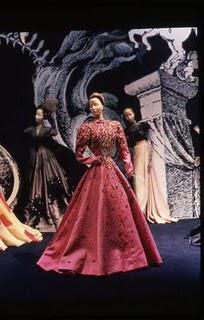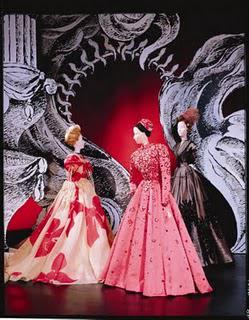
André Dignimont, French (1891-1965) Le Palais Royal, Théâtre de la Mode set, 1945 re-created by Anne Surgers. Lent by Maryhill Museum of Art. Photo by Laurent Scully Jaulmes.
The story of the Théâtre de la Mode, a traveling exhibition meant to raise awareness of the French haute couture industry during World War II, is a fascinating one. Fashion, like every other aspect of life, was hit hard during WWII. When the allies liberated France they were surprised to see that the country did not uphold the imposed wartime silhouette which was in place due to strict fabric rations. But that is because Lucien Lelong, the President of the Chambre Syndicale de la Couture Parisienne since 1937 was fiercely loyal to his designers. Lelong was an established designer in his own right and understood that implementing such a decree would result in the shuttering of fashion houses in Paris. At this point, Lelong had already fought hard for the haute couture industry since in 1940 he had gained permission from the Nazi party to allow the fashion houses to remain in Paris and not move to Berlin. Additionally, when in 1941 the Nazi’s began to ration fabrics, Lelong once again fought them and gained exemptions for the 12 main Parisian couture houses. During the war Lelong employed some of the most promising young designers, like Pierre Balmain and Christian Dior, at his eponymous fashion house. At the end of the war, Lelong was able to “save” the fashion industry and by doing this he saved an estimated 12,000 people, namely the workers, from being sent to Germany.

André Dignimont, French (1891-1965) Le Palais Royal, Théâtre de la Mode set, 1945 re-created by Anne Surgers. Lent by Maryhill Museum of Art. Photo by Laurent Scully Jaulmes.
From 1945-1946 Lelong launched Théâtre de la Mode, an exhibition of 230 dolls all attired by top Parisian designers (Cristobal Balenciaga, Jacques Fath, Elsa Schiaparelli, and Pierre Balmain all participated) and sets created by some of the most renowned artists of the twentieth-century such as Jean Cocteau, Christian Bérard, and Joan Rebull. The sets all recreated daily Parisian life, a reminder of how things were before war tore everything apart. The goal of the exhibition was to show the world the importance of fashion and in particular to demonstrate that the French were the leaders of this craft. The dolls, two feet tall with wire torsos, were first exhibited at the Pavillon Marsan at the Musée des Arts Décoratifs and then went on to travel throughout Europe and America. The tour was able to raise money for war victims and also raise money for the French fashion industry. In 1952 the dolls were donated to Maryhill Museum of Art in Goldengale, WA.

André Beaurepaire, French (b. 1924), Théâtre de la Mode set La Grotte Enchantee, 1945 re-created by Anne Surgers. Lent by Maryhill Museum of Art. Photo by Laurent Scully Jaulmes.
The current exhibition at the Pheonix Art Museum features three of the original scenes on loan from the Maryhill Museum including La grotte enchantée (The Enchanted Grotto), Le jardin merveilleux (The Marvelous Garden) and Le Palais-Royal (The Royal Palace).
In 2009 the International Center of Photography in New York held a wonderful exhibition dedicated to David Seidner’s photographs of the dolls. He captured them in 1990, on the 45th Anniversary of the exhibition, for the Musée de la Mode in Paris. The ICP exhibition, titled "David Seidner: Paris Fashion 1945", featured fifteen of these color photographs along with one of the original dolls.
If you want to know more about this topic, the definitive book is Théâtre de la Mode: Fashion Dolls: the Survival of Haute Couture by Charles- Edmond Roux, Herbert R. Lottman, Stanley Garfinkle, and Nadine Gasc. Oregon: Maryhill Museum of Art, Palmer/Plash Publishing, 2002.
This exhibition is part of the Phenonix Art Museum’s Year in Fashion celebration. Visit http://www.phxart.org/fashion/ for more information. As a side note, the NYT recently published a very interesting article about the recent rise of fashion-related exhibitions in major museums. To read this insightful article, click here.

